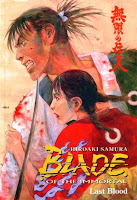 Creator: Hiroaki Samura
Creator: Hiroaki Samura
U.S. publisher: Dark Horse
ISBN: 9781593078713
Released: February 2008
Original release: 2004
Awards: Eisner Award, Japan Media Arts Award
The Sparrow Net, the eighteenth volume of Hiroaki Samura’s award-winning manga series Blade of the Immortal as released in English, was published by Dark Horse in 2008. Dark Horse’s English-language edition of the series divides the individual volumes by story arc rather than strictly by number of chapters. Because of this, The Sparrow Net is most closely equivalent to the seventeenth Japanese volume except that The Sparrow Net includes one additional chapter. Also because of Dark Horse’s tendency to compile the volumes by story arc, The Sparrow Net ends up being on of the longest books in the series. Blade of the Immortal is one of my personal favorites. I’ve been enjoying the manga’s mix of historical fiction, martial arts, and the supernatural along with Samura’s complex characters and great artwork.
After the Ittō-ryū was betrayed and nearly wiped out by the bakufu, the surviving members of the rogue sword school have been quietly working in the background, biding their time and preparing a return assault against the government. Although they are supposed to be in hiding and keeping a low profile while in Edo, two of the Ittō-ryū’s most recent members, Dōa and Isaku, can’t seem to help but draw attention to themselves. After a confrontation with the police force, Isaku goes missing and Dōa is left behind with Rin who in a strange twist of fate has been helping to hide them (her parents were killed by the Ittō-ryū.) Although their relationship is less than ideal, the two young women must work together in order to find both Isaku and Manji, Rin’s bodyguard who has also disappeared under troubling circumstances.
Dōa and Isaku are relatively new characters in Blade of the Immortal having first been introduced towards the end of the fifteenth volume, Trickster. Although Dōa in particular has been shown to be violent and easily provoked, The Sparrow Net is the first time that she and Isaku are seen to really fight. With Isaku’s size and strength and Dōa’s speed and viciousness they make an incredibly effective and formidable team. The Sparrow Net is also the first volume in Blade of the Immortal to delve into the pair’s backstory. Previously, there have been some hints as to their pasts and who they really are, but until now their history has largely remained a mystery. I am still very curious to learn how they joined up with the Ittō-ryū.
While chaos surrounds Dōa and Isaku, Rin continues her search for Manji. Eventually she hears rumor of a bizarre immortality experiment. The procedures being performed on Manji and the other felons have reached disturbing new heights of cruelty. However, this escalation means that more people are involved and it is increasingly difficult to hide. Even those who are only tangentially involved suspect that something horribly wrong is going on. And those who are at the heart of the investigation—the doctors and their assistants, not to mention their human guinea pigs—have all been affected in terrible ways. The change in Ayame Burando, one of the head doctors on the case who himself is on death row, and what that brings about is particularly horrifying. I’m almost afraid to see what is in store in the next volume, Badger Hole.




